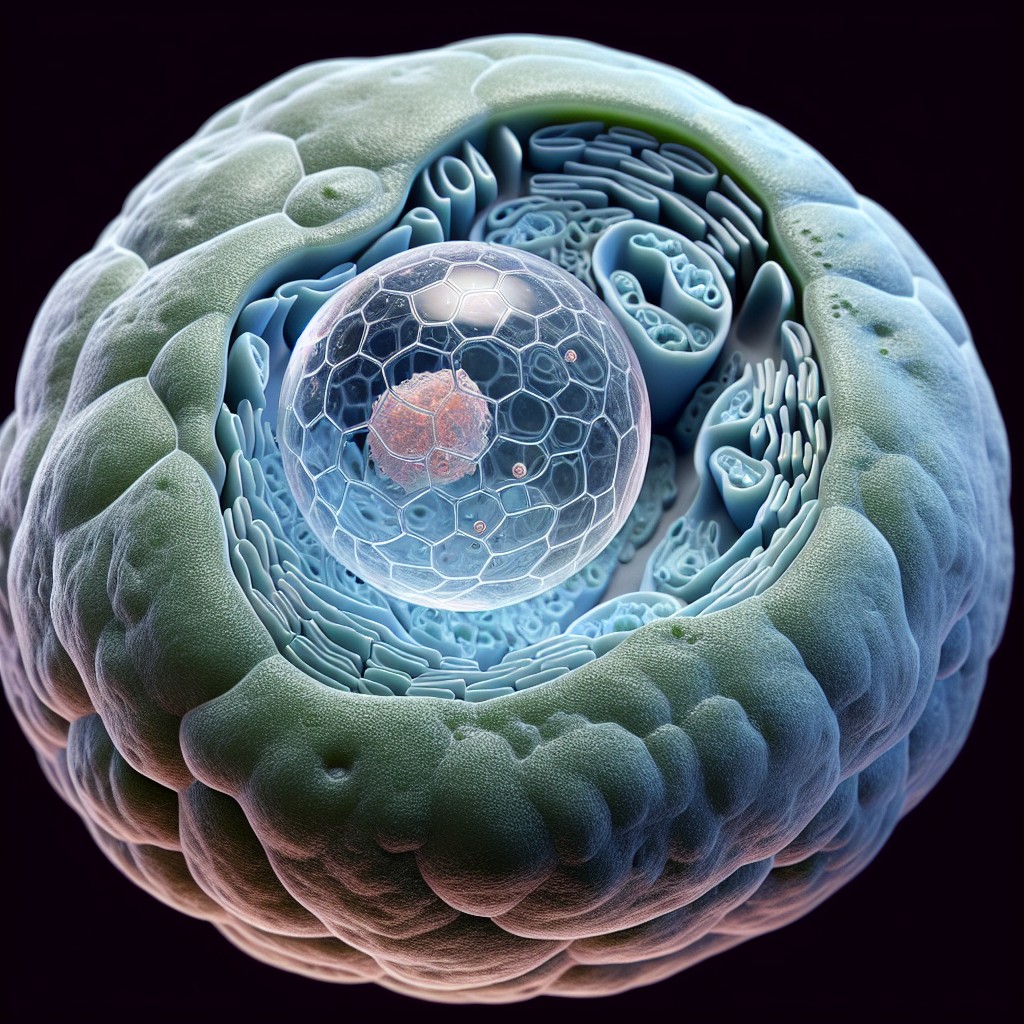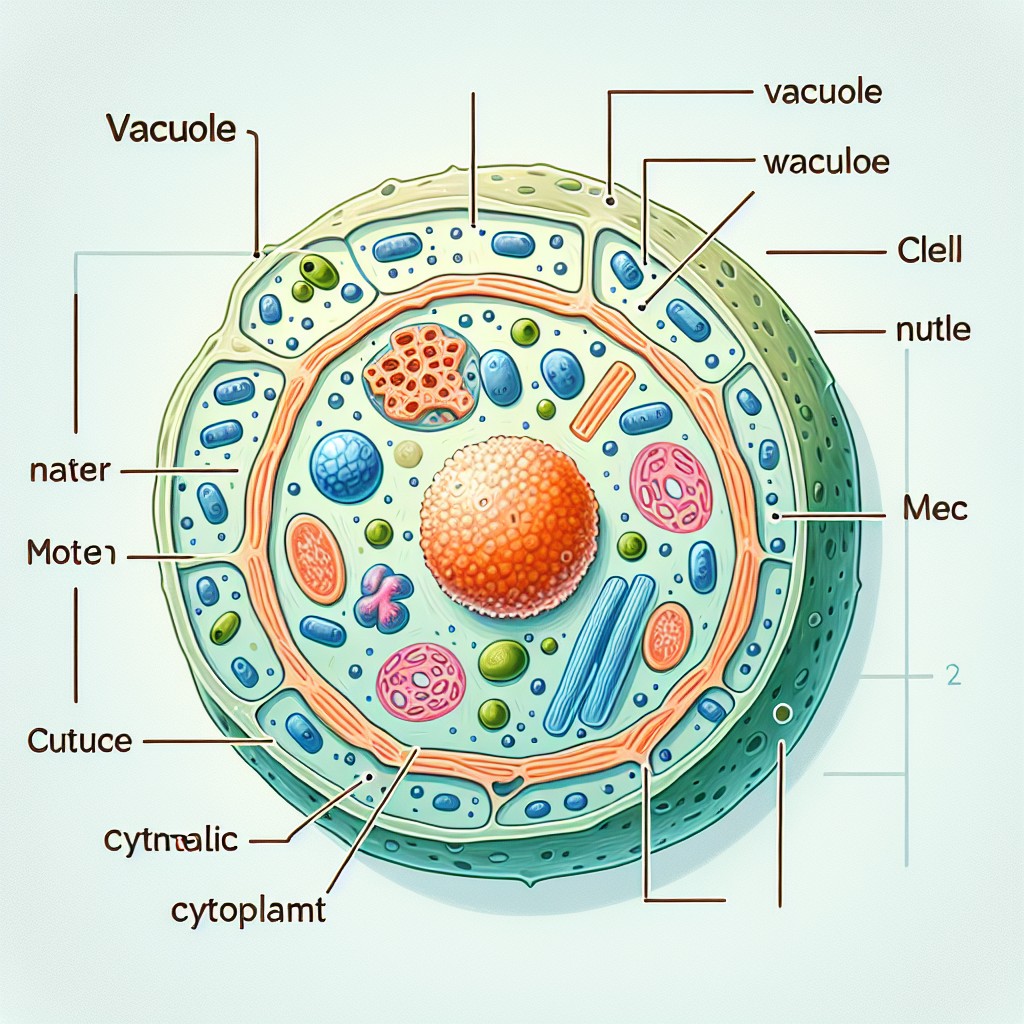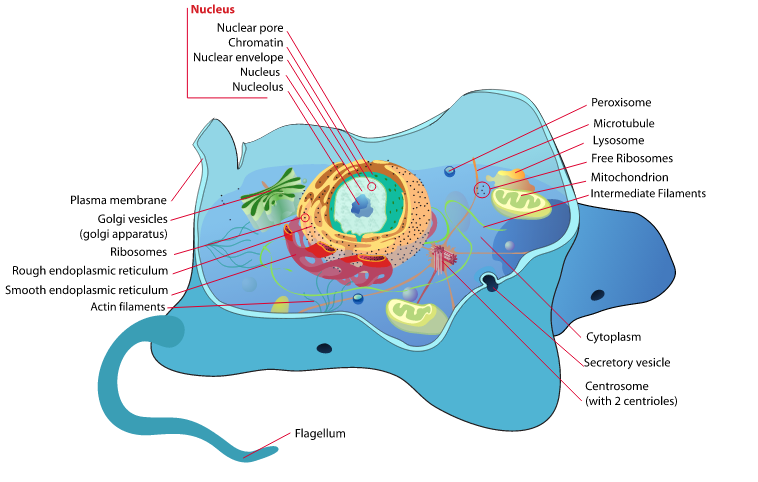
The vacuole is a vital organelle found in the cells of both plants and animals. It is a membrane-bound structure that plays a crucial role in cellular biology. The term “vacuole” comes from the Latin word “vacuus,” meaning empty, as early scientists believed that these organelles were simply empty spaces within the cell. However, we now know that vacuoles are far from empty and are involved in a wide range of important functions.
The vacuole is primarily responsible for storing various substances within the cell. It acts as a storage compartment for water, ions, nutrients, and waste products. In plant cells, vacuoles can occupy up to 90% of the cell’s volume, making them the largest organelles in these cells. In animal cells, vacuoles are smaller and less prominent but still play essential roles in cellular processes.
Key Takeaways
- The vacuole is an organelle found in plant and some animal cells that plays a crucial role in maintaining cellular homeostasis.
- The vacuole is composed of various components, including a membrane, tonoplast, and various enzymes, which work together to carry out its functions.
- In plant cells, the vacuole is responsible for storing nutrients, regulating water balance, and maintaining turgor pressure.
- Vacuoles also play a key role in cellular waste management, cellular defense, growth and development, and cellular signaling.
- Dysfunction of the vacuole can lead to various cellular health issues and diseases, highlighting the importance of continued research in this area.
The Structure of the Vacuole: A Closer Look at Its Components and Functions.
The vacuole is surrounded by a membrane known as the tonoplast, which separates its contents from the cytoplasm of the cell. This membrane is similar to the plasma membrane that surrounds the entire cell but has specific proteins and transporters that allow for selective movement of substances into and out of the vacuole.
There are several types of vacuoles found in different cells. The central vacuole is unique to plant cells and is responsible for maintaining turgor pressure, storing water, and regulating ion concentrations. Contractile vacuoles are found in certain single-celled organisms and are involved in osmoregulation by expelling excess water from the cell. In animal cells, there are smaller vesicles called lysosomes that function similarly to vacuoles by storing and degrading cellular waste.
The functions of vacuoles are diverse and essential for the overall health and functioning of the cell. They play a crucial role in maintaining cellular homeostasis by regulating pH balance and ion concentrations. Vacuoles also store and degrade cellular waste, detoxify harmful substances, and protect cells from pathogens. Additionally, vacuoles are involved in cell expansion and embryonic development.
The Role of the Vacuole in Plant Cells: Understanding Its Unique Functions.
Plant vacuoles differ from animal vacuoles in several ways. Firstly, plant cells typically have one large central vacuole that occupies a significant portion of the cell’s volume. This central vacuole is responsible for maintaining turgor pressure, which gives plant cells their rigidity and allows them to stand upright. The central vacuole also stores water, nutrients, and pigments, contributing to the vibrant colors seen in many flowers and fruits.
In addition to its structural functions, the central vacuole in plant cells also plays a role in regulating ion concentrations. It actively transports ions such as potassium into the vacuole, creating a concentration gradient that drives water uptake by osmosis. This process helps maintain the cell’s water balance and prevents wilting.
Furthermore, plant vacuoles are involved in the storage of various compounds, including sugars, amino acids, and secondary metabolites. These stored compounds can be used for energy production, defense against herbivores or pathogens, or attracting pollinators. The ability of plant vacuoles to store large amounts of water also allows plants to survive in arid environments.
The Importance of Vacuoles in Maintaining Cellular Homeostasis.
| Metrics | Description |
|---|---|
| Vacuole size | Large vacuoles help maintain turgor pressure and prevent wilting. |
| Vacuole pH | Acidic vacuoles help break down waste and toxins. |
| Vacuole storage | Vacuoles store nutrients, such as amino acids and sugars, for later use. |
| Vacuole transport | Vacuoles transport molecules, such as ions and proteins, throughout the cell. |
| Vacuole recycling | Vacuoles recycle cellular components, such as organelles and proteins, through autophagy. |
One of the crucial roles of vacuoles is maintaining cellular homeostasis by regulating pH balance and ion concentrations within the cell. Vacuoles help maintain an optimal pH level by actively pumping protons (H+) into their lumen, creating an acidic environment. This acidic pH is essential for the proper functioning of enzymes and other cellular processes.
Vacuoles also play a vital role in regulating ion concentrations within the cell. They actively transport ions such as potassium (K+), calcium (Ca2+), and chloride (Cl-) into their lumen, creating concentration gradients that drive the movement of water and other solutes. This process helps maintain the cell’s water balance and prevents excessive swelling or shrinking.
Osmoregulation is another critical function of vacuoles. By actively accumulating solutes such as sugars and salts, vacuoles help regulate the osmotic pressure within the cell. This prevents the cell from bursting or shriveling due to changes in external osmotic conditions.
The Relationship Between Vacuoles and Cellular Waste Management.
Vacuoles play a crucial role in cellular waste management by storing and degrading various waste products. In animal cells, lysosomes are specialized vacuoles that contain enzymes capable of breaking down cellular waste materials, such as proteins, lipids, and carbohydrates. These enzymes are highly acidic and work optimally at low pH levels, which is maintained by the vacuolar membrane.
In plant cells, vacuoles also contribute to waste management by storing toxic compounds produced during metabolic processes. For example, some plants produce alkaloids as a defence mechanism against herbivores or pathogens. These alkaloids are stored in vacuoles, preventing them from harming the rest of the cell. Additionally, vacuoles can sequester heavy metals and other harmful substances, protecting the cell from their toxic effects.
The Vacuole and Cellular Defense: How it Helps Protect Cells from Harmful Substances.
Vacuoles play a crucial role in cellular defence by sequestering harmful substances and protecting cells from pathogens. In plant cells, vacuoles can store toxic compounds that act as chemical defences against herbivores or pathogens. These compounds can include alkaloids, phenolics, and terpenoids, which are toxic to many organisms. By storing these compounds in vacuoles, plants can protect themselves from potential threats.
Vacuoles also play a role in protecting cells from pathogens. When a pathogen enters a plant cell, the vacuole can engulf it through a process called endocytosis. Once inside the vacuole, the pathogen is isolated from the rest of the cell, preventing it from causing further damage. The vacuole can then fuse with lysosomes, which contain enzymes capable of degrading the pathogen.
In animal cells, lysosomes perform a similar function by engulfing and degrading pathogens or cellular debris. Lysosomes can fuse with phagosomes, which are vesicles that engulf pathogens, forming a phagolysosome. This fusion allows the lysosomal enzymes to degrade the pathogen and eliminate the threat.
The Role of Vacuoles in Cellular Growth and Development.
Vacuoles play an essential role in cellular growth and development by contributing to cell expansion and embryonic development. In plant cells, the central vacuole is responsible for maintaining turgor pressure, which gives the cell its rigidity and allows it to expand. As water enters the vacuole by osmosis, it exerts pressure on the cell wall, causing it to expand. This process is crucial for plant growth and allows plants to reach their full size.
During embryonic development in plants, vacuoles also play a role in cell elongation and differentiation. As cells divide and differentiate into different tissues and organs, vacuoles help regulate cell expansion by controlling water uptake and maintaining turgor pressure. This ensures that cells grow in a coordinated manner and form the correct structures.
In animal cells, vacuoles are involved in various developmental processes, such as the formation of the blastocyst during early embryonic development. The blastocyst is a hollow ball of cells that eventually implants into the uterine wall and gives rise to the embryo. Vacuoles within the blastocyst play a role in maintaining its structure and facilitating implantation.
Vacuoles and Cellular Signaling: Understanding How They Communicate with Other Organelles.
Vacuoles play a role in cellular signaling by participating in intracellular signaling pathways and facilitating intercellular communication. Within the cell, vacuoles can act as storage compartments for signaling molecules, such as calcium ions (Ca2+). Calcium ions are involved in various cellular processes, including muscle contraction, neurotransmitter release, and gene expression. By storing calcium ions, vacuoles can regulate their concentration and release them when needed to initiate specific signaling events.
Vacuoles also contribute to intercellular communication by releasing signaling molecules into the extracellular space. In plant cells, vacuoles can release hormones and other signaling molecules into the cell wall, where they can diffuse to neighboring cells and initiate a response. This allows plants to coordinate their growth and development and respond to environmental cues.
In animal cells, lysosomes can also participate in intercellular communication by releasing signaling molecules. For example, lysosomes can release enzymes called cathepsins, which can activate other enzymes or receptors on neighboring cells. This process is involved in various physiological processes, including immune responses and tissue repair.
The Impact of Vacuole Dysfunction on Cellular Health and Disease.
Dysfunction of vacuoles can have severe consequences for cellular health and contribute to the development of various diseases. In some cases, genetic mutations or defects in the proteins involved in vacuole formation or function can lead to vacuolar storage disorders. These disorders are characterized by the accumulation of substances within vacuoles, leading to cellular damage and dysfunction.
One example of a vacuolar storage disorder is lysosomal storage diseases, which are caused by defects in lysosomal enzymes. Without functional lysosomes, cellular waste products cannot be properly degraded, leading to their accumulation within the cell. This can result in a wide range of symptoms, depending on the specific enzyme affected, including developmental delays, organ dysfunction, and neurodegeneration.
Vacuole dysfunction can also contribute to the development of neurodegenerative diseases such as Alzheimer’s and Parkinson’s disease. In these diseases, abnormal protein aggregates accumulate within cells, including neurons. Vacuoles play a role in the degradation of these protein aggregates through autophagy, a process by which cells recycle their own components. Dysfunction of vacuoles can impair autophagy and lead to the accumulation of toxic protein aggregates, contributing to disease progression.
Future Directions in Vacuole Research: Exploring New Frontiers in Cellular Biology.
Vacuole research is an exciting and rapidly evolving field in cellular biology. Scientists are continually uncovering new aspects of vacuole structure and function and exploring their potential applications in medicine and biotechnology.
One emerging area of vacuole research is the study of exosomes, small vesicles that are released by cells and contain various molecules such as proteins, nucleic acids, and lipids. Exosomes are thought to play a role in intercellular communication and have been implicated in various physiological processes and diseases. Understanding how vacuoles contribute to the formation and release of exosomes could provide valuable insights into their functions and potential therapeutic applications.
Another area of interest is the role of vacuoles in cellular ageing and longevity. Vacuoles have been implicated in the regulation of lifespan in various organisms, including yeast and worms. By studying how vacuoles contribute to the ageing process, scientists hope to uncover new strategies for promoting healthy aging and preventing age-related diseases.
Furthermore, vacuoles have potential applications in biotechnology and medicine. For example, vacuoles could be used as storage compartments for therapeutic molecules, allowing for targeted delivery and controlled release. Vacuoles could also be engineered to produce valuable compounds, such as pharmaceuticals or biofuels, in a sustainable and cost-effective manner.
In conclusion, vacuoles are essential organelles that play a wide range of functions in cellular biology. They are involved in maintaining cellular homeostasis, storing and degrading waste products, protecting cells from harmful substances, and contributing to cellular growth and development. Dysfunction of vacuoles can have severe consequences for cellular health and contribute to the development of various diseases. However, ongoing research in the field of vacuole biology is uncovering new insights into their structure and function and exploring their potential applications in medicine and biotechnology.
FAQs
What is a vacuole?
A vacuole is a membrane-bound organelle found in the cells of plants, fungi, and some protists. It is a space filled with fluid and various molecules.
What is the function of a vacuole?
The function of a vacuole varies depending on the type of cell it is found in. In plant cells, vacuoles store water, nutrients, and waste products. They also help maintain the shape and rigidity of the cell. In some protists, vacuoles are used for digestion and excretion.
How is a vacuole formed?
Vacuoles are formed by the fusion of smaller vesicles with the cell membrane. These vesicles contain various molecules that are then transported into the vacuole.
What is the difference between a plant cell vacuole and an animal cell vacuole?
Plant cell vacuoles are much larger than animal cell vacuoles and are essential for maintaining the shape and rigidity of the cell. Animal cell vacuoles are smaller and are mainly used for storage and transport of molecules.
Can vacuoles be found in human cells?
Vacuoles are not typically found in human cells. However, some specialized cells, such as white blood cells, may contain small vacuoles that are used for storage and transport of molecules.



